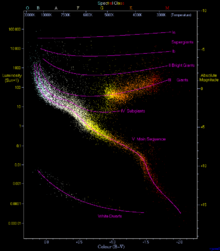Hertzsprung gap: Difference between revisions
Citation bot (talk | contribs) Add: bibcode, doi-access, authors 1-1. Removed URL that duplicated identifier. Removed parameters. Some additions/deletions were parameter name changes. | Use this bot. Report bugs. | Suggested by Headbomb | Linked from Wikipedia:WikiProject_Academic_Journals/Journals_cited_by_Wikipedia/Sandbox | #UCB_webform_linked 695/751 |
|||
| (5 intermediate revisions by 4 users not shown) | |||
| Line 1: | Line 1: | ||
{{Short description|Feature of the Hertzsprung-Russell diagram}} |
{{Short description|Feature of the Hertzsprung-Russell diagram}} |
||
[[File:HRDiagram.png|thumb|right|[[Hertzsprung–Russell diagram]] with the Hertzsprung Gap visible as an area containing few stars between the [[main sequence]] and [[red-giant branch]] ]] |
[[File:HRDiagram.png|thumb|right|[[Hertzsprung–Russell diagram]] with the Hertzsprung Gap visible as an area containing few stars between the [[main sequence]] and [[red-giant branch]] ]] |
||
The '''Hertzsprung |
The '''Hertzsprung gap''' is a feature of the [[Hertzsprung–Russell diagram]] for a star cluster. This diagram is a plot of [[effective temperature]] versus luminosity for a population of stars. The gap is named after [[Ejnar Hertzsprung]], who first noticed the absence of stars in the region of the Hertzsprung–Russell diagram<ref>{{cite journal |last1=Hoyle |first1=F |title=On The Main-Sequence Band and the Hertzsprung Gap |journal=Monthly Notices of the Royal Astronomical Society |date=May 7, 1959 |volume=120 |page=22 |bibcode=1960MNRAS.120...22H |doi=10.1093/mnras/120.1.22 |doi-access=free }}</ref> between A5 and G0 [[spectral type]] and between +1 and −3 [[absolute magnitude]]s. This gap lies between the top of the [[main sequence]] and the base of [[red giant]]s for stars above roughly 1.5 [[solar mass]]. When a star during its [[Stellar evolution|evolution]] crosses the Hertzsprung gap, it means that it has finished [[proton–proton chain|core hydrogen burning]]. |
||
Stars do exist in the Hertzsprung gap region, but because they move through this section of the Hertzsprung–Russell diagram very quickly in comparison to the lifetime of the star (thousands of years, compared to |
Stars do exist in the Hertzsprung gap region, but because they move through this section of the Hertzsprung–Russell diagram very quickly in comparison to the lifetime of the star (thousands of years, compared to millions or billions of years for the lifetime of the star<ref name="e090">{{cite book | last1=Binney | first1=James | last2=Merrifield | first2=Michael | title=Galactic Astronomy | publisher=Princeton University Press | publication-place=Princeton, NJ | date=1998-09-06 | isbn=978-0-691-02565-0 | pages=266–271}} Table 5.2, Figure 5.2.</ref>), that portion of the diagram is less densely populated. |
||
Full Hertzsprung–Russell diagrams of the 11,000 [[Hipparcos]] mission targets show a handful of stars in that region.<ref>Binney, J. and Merrifield, M., "Galactic Astronomy," Figure 3.5, pp. 102–103, p. 265.</ref>{{not in source|date=June 2016}} |
Full Hertzsprung–Russell diagrams of the 11,000 [[Hipparcos]] mission targets show a handful of stars in that region.<ref>Binney, J. and Merrifield, M., "Galactic Astronomy," Figure 3.5, pp. 102–103, p. 265.</ref>{{not in source|date=June 2016}} |
||
Well-known stars inside of or towards the end of the Hertzsprung gap include:<ref name=":0">{{Cite journal |last1=Neuhäuser |first1=R |last2=Torres |first2=G |last3=Mugrauer |first3=M |last4=Neuhäuser |first4=D L |last5=Chapman |first5=J |last6=Luge |first6=D |last7=Cosci |first7=M |date=2022-07-29 |title=Colour evolution of Betelgeuse and Antares over two millennia, derived from historical records, as a new constraint on mass and age |journal=Monthly Notices of the Royal Astronomical Society |volume=516 |issue=1 |pages=693–719 |doi=10.1093/mnras/stac1969 |doi-access=free |issn=0035-8711|arxiv=2207.04702 |bibcode=2022MNRAS.516..693N }}</ref> |
|||
* [[Epsilon Pegasi]] |
|||
* [[Pi Puppis]] |
|||
* [[Epsilon Geminorum]] |
|||
* [[Beta Arae]] |
|||
* [[Gamma Cygni]] |
|||
* [[Capella]] B |
|||
[[Canopus]], [[Iota Carinae]], and [[Upsilon Carinae]] are also starting to enter the gap.<ref name=":0" /> |
|||
==See also== |
==See also== |
||
Latest revision as of 01:41, 18 July 2024

The Hertzsprung gap is a feature of the Hertzsprung–Russell diagram for a star cluster. This diagram is a plot of effective temperature versus luminosity for a population of stars. The gap is named after Ejnar Hertzsprung, who first noticed the absence of stars in the region of the Hertzsprung–Russell diagram[1] between A5 and G0 spectral type and between +1 and −3 absolute magnitudes. This gap lies between the top of the main sequence and the base of red giants for stars above roughly 1.5 solar mass. When a star during its evolution crosses the Hertzsprung gap, it means that it has finished core hydrogen burning.
Stars do exist in the Hertzsprung gap region, but because they move through this section of the Hertzsprung–Russell diagram very quickly in comparison to the lifetime of the star (thousands of years, compared to millions or billions of years for the lifetime of the star[2]), that portion of the diagram is less densely populated. Full Hertzsprung–Russell diagrams of the 11,000 Hipparcos mission targets show a handful of stars in that region.[3][failed verification]
Well-known stars inside of or towards the end of the Hertzsprung gap include:[4]
Canopus, Iota Carinae, and Upsilon Carinae are also starting to enter the gap.[4]
See also
[edit]References
[edit]- ^ Hoyle, F (May 7, 1959). "On The Main-Sequence Band and the Hertzsprung Gap". Monthly Notices of the Royal Astronomical Society. 120: 22. Bibcode:1960MNRAS.120...22H. doi:10.1093/mnras/120.1.22.
- ^ Binney, James; Merrifield, Michael (1998-09-06). Galactic Astronomy. Princeton, NJ: Princeton University Press. pp. 266–271. ISBN 978-0-691-02565-0. Table 5.2, Figure 5.2.
- ^ Binney, J. and Merrifield, M., "Galactic Astronomy," Figure 3.5, pp. 102–103, p. 265.
- ^ a b Neuhäuser, R; Torres, G; Mugrauer, M; Neuhäuser, D L; Chapman, J; Luge, D; Cosci, M (2022-07-29). "Colour evolution of Betelgeuse and Antares over two millennia, derived from historical records, as a new constraint on mass and age". Monthly Notices of the Royal Astronomical Society. 516 (1): 693–719. arXiv:2207.04702. Bibcode:2022MNRAS.516..693N. doi:10.1093/mnras/stac1969. ISSN 0035-8711.
